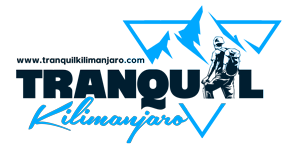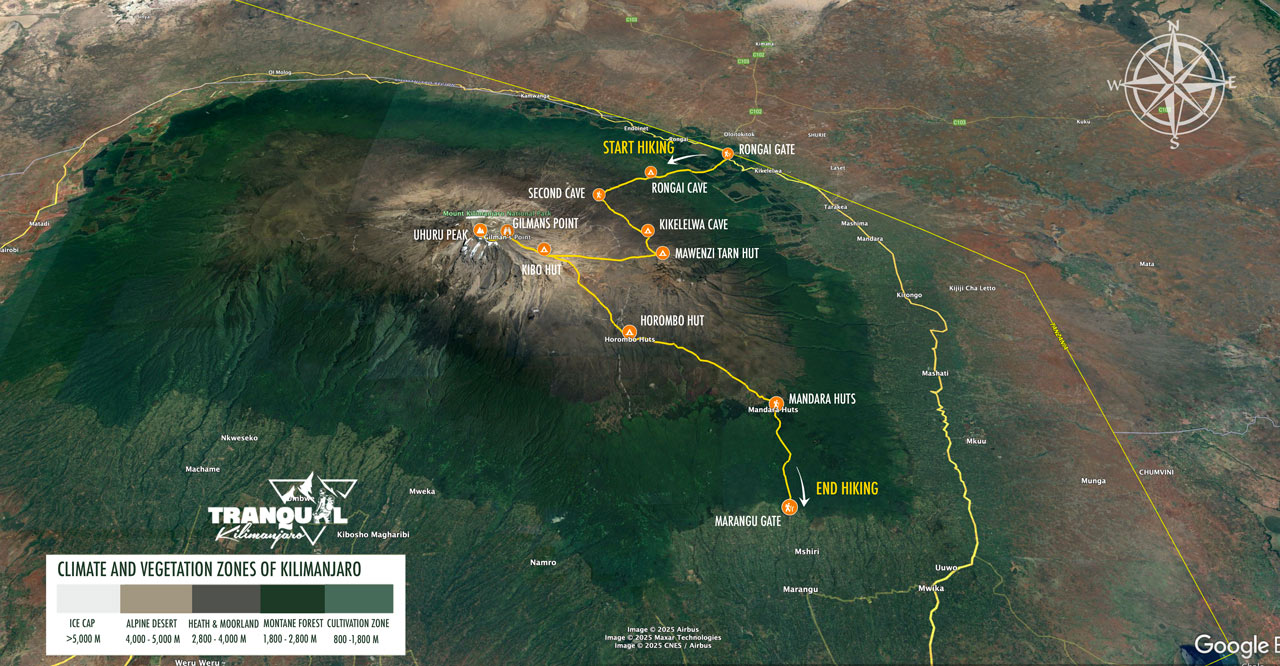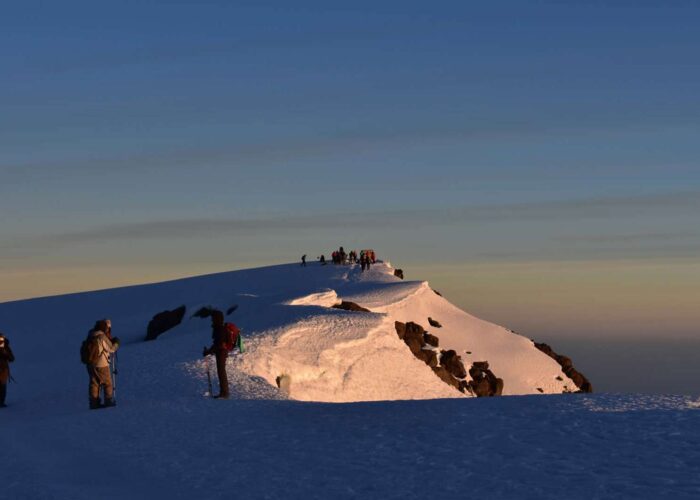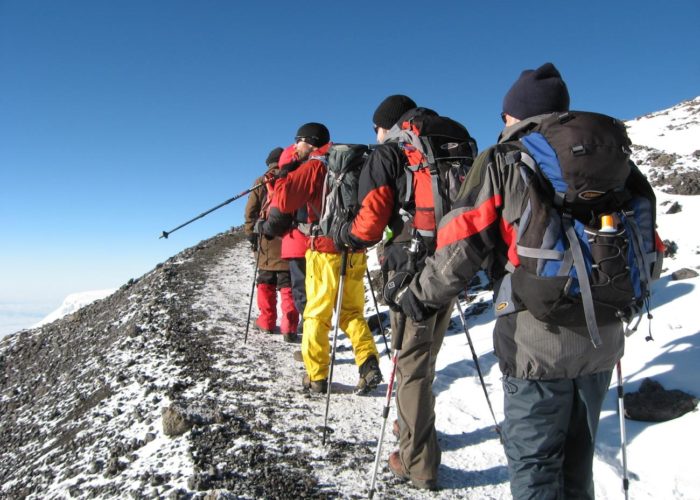Where will I sleep along the Rongai Route?
Approaching from the north, the Rongai Route is less crowded and drier. Climbers sleep in tents at most camps but may have the option of a hut during descent. The first night is at Simba Camp (2,625m), followed by Second Cave Camp (3,480m), Kikilewa Camp (3,630m), and Mawenzi Tarn Camp (4,310m). The final camp before the summit is Kibo Camp (4,700m). After summiting via Gilman’s Point (5,685m), climbers descend via Horombo Hut (3,720m), where they can stay in a hut for the night before exiting through Mweka Gate (1,640m). Thus, while the majority of the route involves tent camping, the descent may include a night in a hut.
What Will I Eat When Trekking the Rongai Route?
When trekking the Rongai Route, known for its quieter trails and unique northern approach to Mount Kilimanjaro, you’ll enjoy full board service with professional cooks preparing three hot meals daily, along with snacks and beverages. The meals are carefully crafted to provide the energy and nutrients required for high-altitude trekking, with menus balanced in carbohydrates, proteins, and fats to keep you fueled. We recommend notifying us of any dietary restrictions in advance, as we can accommodate vegetarian and vegan diets. For more details, check our sample meal plan and menu here.
Breakfast
Kick off your day with a hearty breakfast to power your trek. Typical offerings include:
- Porridge with milk – warm and energy-rich
- Boiled or fried eggs – protein to keep you strong
- Bread or toast with spreads like butter, jam, or peanut butter
- Fresh fruit such as bananas or oranges
- Hot beverages like tea, coffee, or hot chocolate
Served in the serene, less-crowded campsites of the Rongai Route, breakfast sets you up for the day’s adventure.
Lunch
Lunch is designed to be portable and nutritious, perfect for refuelling on the trail. Expect:
- Sandwiches with fillings like meat, cheese, or egg
- Fresh fruit – a refreshing addition
- Sliced vegetables – light and healthy
- Macaroni with meat sauce – occasionally included for variety
- On some days, a hot lunch may be prepared at a campsite, offering a warm break during your trek
The remote nature of the Rongai Route means meals are often enjoyed in peaceful, scenic surroundings.
Dinner
After a day of trekking, dinner is a hot, satisfying meal to restore your energy. It typically includes:
- Stews or curries with meat – hearty and flavorful
- Rice or pasta – carb-heavy staples
- Grilled meats – protein-rich options
- Vegetables – essential nutrients
- Bread or chapati as a side
Dinners are served at camp, providing a cozy moment to relax and enjoy the tranquil ambiance of the Rongai Route’s northern slopes.
Energy Snacks
To maintain energy levels during hikes, you’ll have access to snacks throughout the day, including:
- Nuts (e.g., peanuts, almonds)
- Dried fruits (e.g., apricots, raisins)
- Chocolate bars
- Cookies
- Popcorn
- Energy bars
These snacks are ideal for quick energy boosts while navigating the route’s gradual ascent.
Vegetarian and Vegan Diets
We’re happy to accommodate vegetarian and vegan diets with advance notice. More about a vegetarian diet for Rongai treks can be found here.
- Vegetarian options may include tofu scramble, cheese sandwiches, and lentil curries.
- Vegan options could feature plant-based meals like hummus wraps, vegan chili, and overnight oats with plant-based milk.
For more information on vegetarian diets, see here (#).
The Rongai Route’s quieter, more remote setting pairs perfectly with a well-planned meal schedule, ensuring you’re nourished and ready to tackle the climb to Uhuru Peak!
Difference between the Rongai 7 Days & 6 days itineraries
Tranquil Kilimanjaro offers 6-day and 7-day itineraries for the Rongai Route trek. The primary difference between these two itineraries is the inclusion of an additional acclimatisation day in the 7-day version, which significantly enhances summit success rates and comfort, especially for beginners.
- 6-Day Itinerary:On Day 3 or 4, trekkers hike from Kikelewa Camp (3,630 m) directly to School Hut Camp (4,715 m) or Kibo Hut (4,700 m), covering a significant altitude gain in one day. This can be physically demanding and increases the risk of altitude sickness due to the rapid ascent
This is a faster-paced trek that skips an acclimatization day, typically at Mawenzi Tarn. It involves longer hiking days and less time to adjust to altitude, making it more challenging and suitable for experienced trekkers or those with prior high-altitude exposure. The summit success rate is lower, estimated at 65–75% for Uhuru Peak.
- 7-Day Itinerary: Includes an extra day, usually at Mawenzi Tarn, dedicated to acclimatization. This allows trekkers to rest or take a short hike to aid altitude adjustment, improving comfort and increasing summit success rates to around 80–90%. It’s recommended for beginners or those without prior acclimatization.Day 4 is typically spent at Mawenzi Tarn Camp (4,310–4,330 m), with a short acclimatization hike (e.g., 200 m gain toward Mawenzi Volcano). This breaks up the ascent, allowing the body to adjust before proceeding to School Hut or Kibo Hut on Day 5
What makes this route unique, and why should you choose Rongai?
The Rongai Route is distinctive for its northern approach, near the Kenyan border, offering a drier and less crowded alternative, particularly during rainy seasons. It typically takes 6-7 days and is considered one of the easier routes with a moderate ascent profile, aiding acclimatisation. Its uniqueness lies in providing a different perspective of the mountain, with descent via the Marangu Route, allowing climbers to experience two paths. This route is noted for its tranquillity and scenic beauty. See www.rongairoute.com for detailed information about Rongai Route.




























